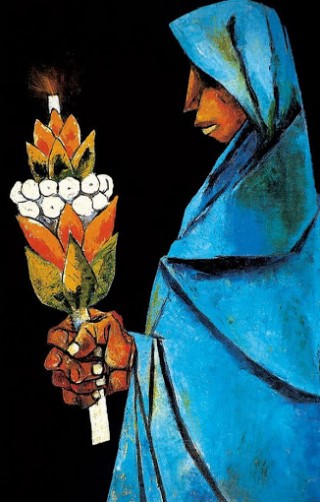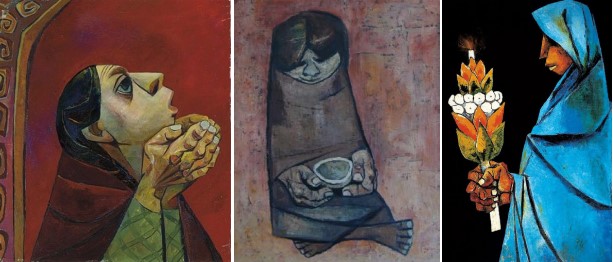Advent - Eduardo Kingman: Procession
Eduardo Kingman: Procession

Come, Lord Jesus, Come
by Victoria Emily Jones
One of Ecuador’s most famous artists, Eduardo Kingman was committed to exposing the poverty and toil of indigenous populations in his native country and abroad. He abandoned picturesque painting in favor of social realism, portraying working men and women in postures of exhaustion, waiting, grief, or petition. Like his colleague Oswaldo Guayasamín, he often used hands as the locus of emotional expression, emphasizing them through anatomical deformation. They’re always rough and gnarled.

The three images here show hands clasped in prayer, cradling an alms bowl, clenching a candlestick—and so offer fitting illustrations to the refrain “Come, Lord Jesus, come.” In our desire to see the glory of Christ manifest, we call out, we beg, we keep vigil.
A traditional Advent scripture reading is the parable of the ten virgins from Matthew 25:1–13, which Jesus used to teach his disciples to be ready for his second coming:
Then the kingdom of heaven will be like ten virgins who took their lamps and went to meet the bridegroom. Five of them were foolish, and five were wise. For when the foolish took their lamps, they took no oil with them, but the wise took flasks of oil with their lamps. As the bridegroom was delayed, they all became drowsy and slept. But at midnight there was a cry, ‘Here is the bridegroom! Come out to meet him.’ Then all those virgins rose and trimmed their lamps. And the foolish said to the wise, ‘Give us some of your oil, for our lamps are going out.’ But the wise answered, saying, ‘Since there will not be enough for us and for you, go rather to the dealers and buy for yourselves.’ And while they were going to buy, the bridegroom came, and those who were ready went in with him to the marriage feast, and the door was shut. Afterward the other virgins came also, saying, ‘Lord, lord, open to us.’ But he answered, ‘Truly, I say to you, I do not know you.’ Watch therefore, for you know neither the day nor the hour.
The blue-cloaked woman of Kingman’s Procession could be read as one of the wise virgins of this parable, who stands in midnight darkness with a large supply of candles in stock, waiting for the groom to return. When he does, she will process to his house for the commencement of a magnificent wedding feast.
The other two Kingman figures also reinforce our Advent work: With open mouths we cry “O” and beseech God’s presence. With empty bowls we beg for the fullness only he can bring. In one the woman’s eyes are upcast, searching out the skies; in the other, downcast, expressing humility, or maybe a tiredness wrought by repeated asking.
In his poem “Christ’s Nativity,” Henry Vaughan highlights our spiritual neediness and summons Christ, in his own words, into hearts and lives:
I would I had in my best part
Fit rooms for thee! or that my heart
Were so clean as
Thy manger was!
But I am all filth, and obscene;
Yet, if thou wilt, thou canst make clean.
Sweet Jesu! will then. Let no more
This leper haunt and soil thy door!
Cure him, ease him,
O release him!
And let once more, by mystic birth,
The Lord of life be born in earth.
Despite the grimness of things, we must persist in our “O come, Lord Jesus, come.” We must burn bright our lamps of hopefulness, hold out our empty bowls, and pray that Christ indwells us and this whole earth.
*******
This meditation originally appeared in 2016 in the self-published Advent devotional booklet Come, Lord Jesus, Come, available for free download from ArtandTheology.org. Reprinted with permission.
Eduardo Kingman: Procession, 1968, oil on canvas.
Eduardo Kingman: Prayer, 1956, oil on canvas.
Eduardo Kingman: Untitled, 1965, oil on canvas.
Eduardo Kingman (1913–1997) was an Ecuadorian artist whose paintings depicted the people of his country with stylized forms and vibrant colors. He was a renowned social activist and outspoken author of socially conscious literature. Similar to his peer Oswaldo Guayasamín (1919-1999), his work was informed by a deep investment in the plight of Ecuador’s indigenous people in contemporary society. Born on February 23, 1913 in Loja, Ecuador, he studied at the Escuela de Bellas Artes in Quito, before travelling to the United States to study at the San Francisco Art Institute. Kingman’s career culminated in a solo exhibition at the United Nations in New York. The artist died on November 27, 1997 in Quito, Ecuador. (source)
Victoria Emily Jones lives in the Baltimore area of the United States, where she works as an editorial freelancer and blogs at ArtandTheology.org, exploring ways in which the arts can stimulate renewed engagement with the Bible. She serves on the board of the faith-based arts nonprofit the Eliot Society and as art curator for the Daily Prayer Project, and she has contributed to the Visual Commentary on Scripture and the Encyclopedia of the Bible and Its Reception. Follow her on Instagram (@art_and_theology), Twitter (@artandtheology), and Facebook.
ArtWay Visual Meditation Advent 1, 2021


